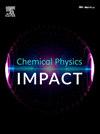吕立康唑抗真菌niosomal凝胶的研制与表征:体外与离体方法
IF 3.8
Q2 CHEMISTRY, PHYSICAL
引用次数: 0
摘要
乳小体是多层囊泡,能有效地将活性物质转移到表皮层或循环。它们改善了局部给药系统中活性药物的皮肤渗透。本研究的目的是研制一种促进皮肤通透性的luliconazole (LCZ) niosomal gel。露立康唑治疗由絮状表皮菌和红毛癣菌引起的足癣、癣和体癣。露立康唑改善皮肤药代动力学。在所有的配方中,胆固醇的比例一致,并采用醚注射法,用60或80之间的表面活性剂制备。测定了捕集体的捕集效率、粒径、PDI和zeta电位。粒径为60的lspii型配方具有最高的噪声截留效果(EE),因此采用卡波波尔凝胶对其进行处理。测定了乳质体凝胶pH、膨胀性、挤压性、实际产率、药物含量、体外药物释放量、体外渗透性和生物参数抗真菌活性。在pH 6.5 ~ 7.4范围内,膜体凝胶具有良好的均匀性、扩展性和可压缩性。4个剂型中,F2的药浓度最高(89.70±1.065%)。体外药物释放研究使用pH 7.4磷酸盐缓冲液。试验24 h后,F2处方的体外释药率最高(92.09±2.69%)。Franz扩散池体外渗透研究表明,F4具有良好的药物穿透性和通过动物皮肤的通量。杯盘法对白色念珠菌的抑菌效果优于市售制剂。本文章由计算机程序翻译,如有差异,请以英文原文为准。

Development and characterization of antifungal niosomal gel of luliconazole: In vitro and ex vivo approaches
Niosomes are multilamellar vesicles that efficiently transfer active substances to epidermal layers or circulation. They improve “active drug skin penetration in topical drug delivery systems. The goal of this work was to develop a luliconazole (LCZ) niosomal gel to promote skin permeability. Luliconazole treats tinea pedis, cruris, and corporis caused by Epidermophyton floccosum and Trichophyton rubrum. Luliconazole has improved skin pharmacokinetics. In the all formulations, the cholesterol ratio was consistent and was prepared by ether injection method using span 60 or tween 80 surfactants. The niosome's entrapment efficiency, size, PDI, and zeta potential were measured. The LSP II formulation with span 60 had the highest noisome entrapment effectiveness (EE), hence carbopol gel was used into it. Niosomal gel pH, spredability, extrudability, practical yield, drug content, in vitro drug release, ex vivo permeability, and biological parameter antifungal activity were measured. The niosomal gel had good homogeneity, spredability, and extrudability at pH 6.5 to 7.4. Out of 4 formulations, F2 had the highest drug concentration (89.70±1.065 %). In vitro drug release investigations used pH 7.4 phosphate buffer. In vitro drug release was highest in formulation F2 (92.09±2.69 %) after 24 h of testing. Franz diffusion cell ex vivo permeation studies of formulation F4 showed excellent drug penetration and flux via animal skin. The cup plate technique showed that formulation F2 had better antifungal efficacy than commercialized formulation against Candida albicans strain.”
求助全文
通过发布文献求助,成功后即可免费获取论文全文。
去求助
来源期刊

Chemical Physics Impact
Materials Science-Materials Science (miscellaneous)
CiteScore
2.60
自引率
0.00%
发文量
65
审稿时长
46 days
 求助内容:
求助内容: 应助结果提醒方式:
应助结果提醒方式:


